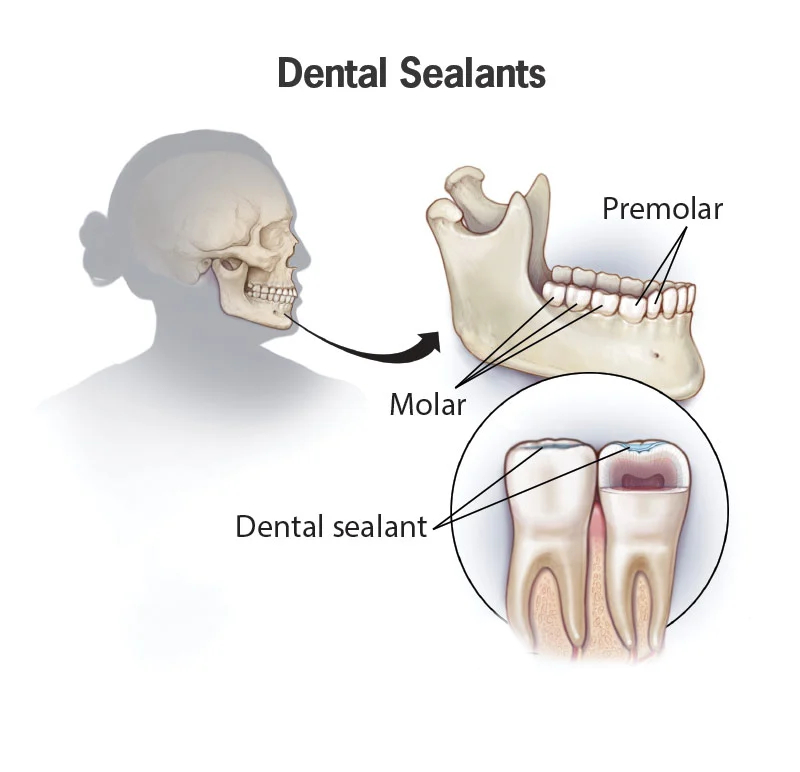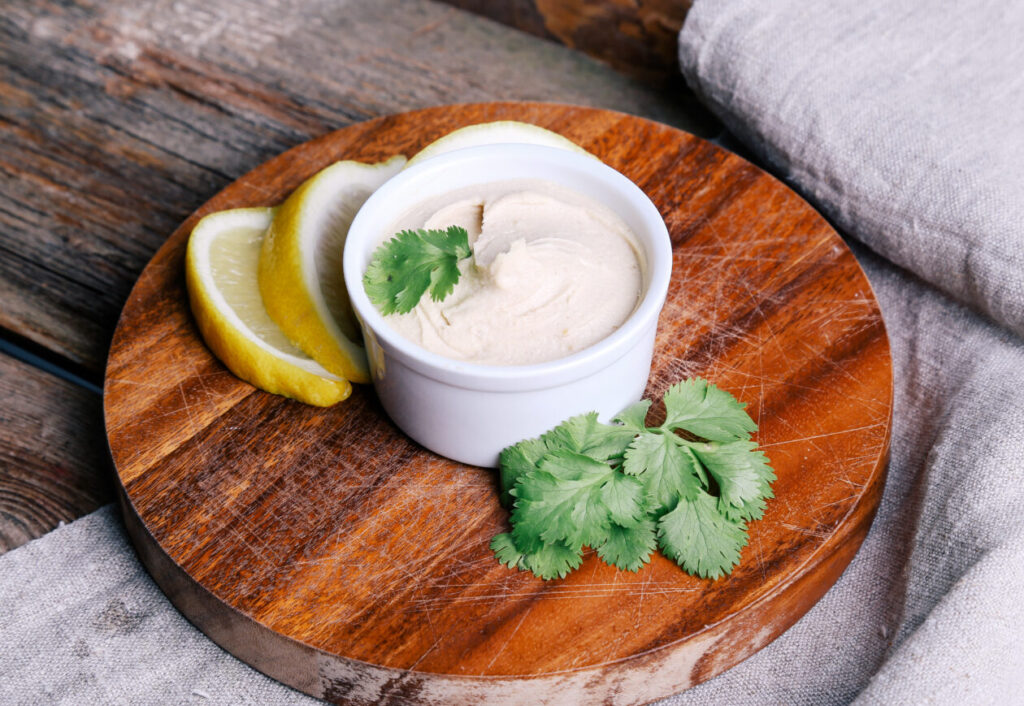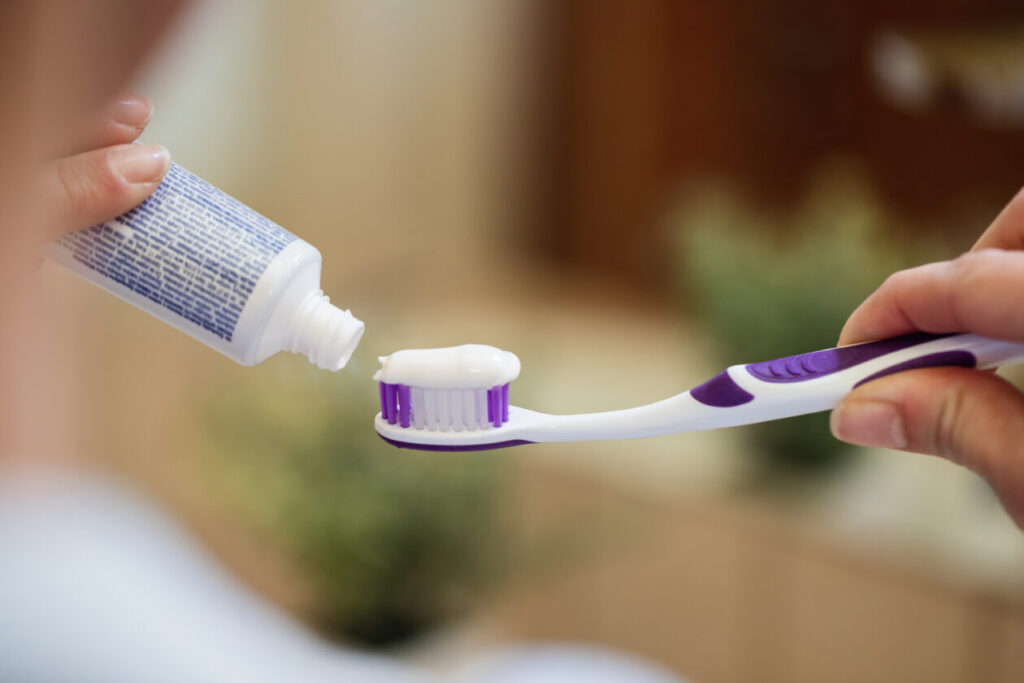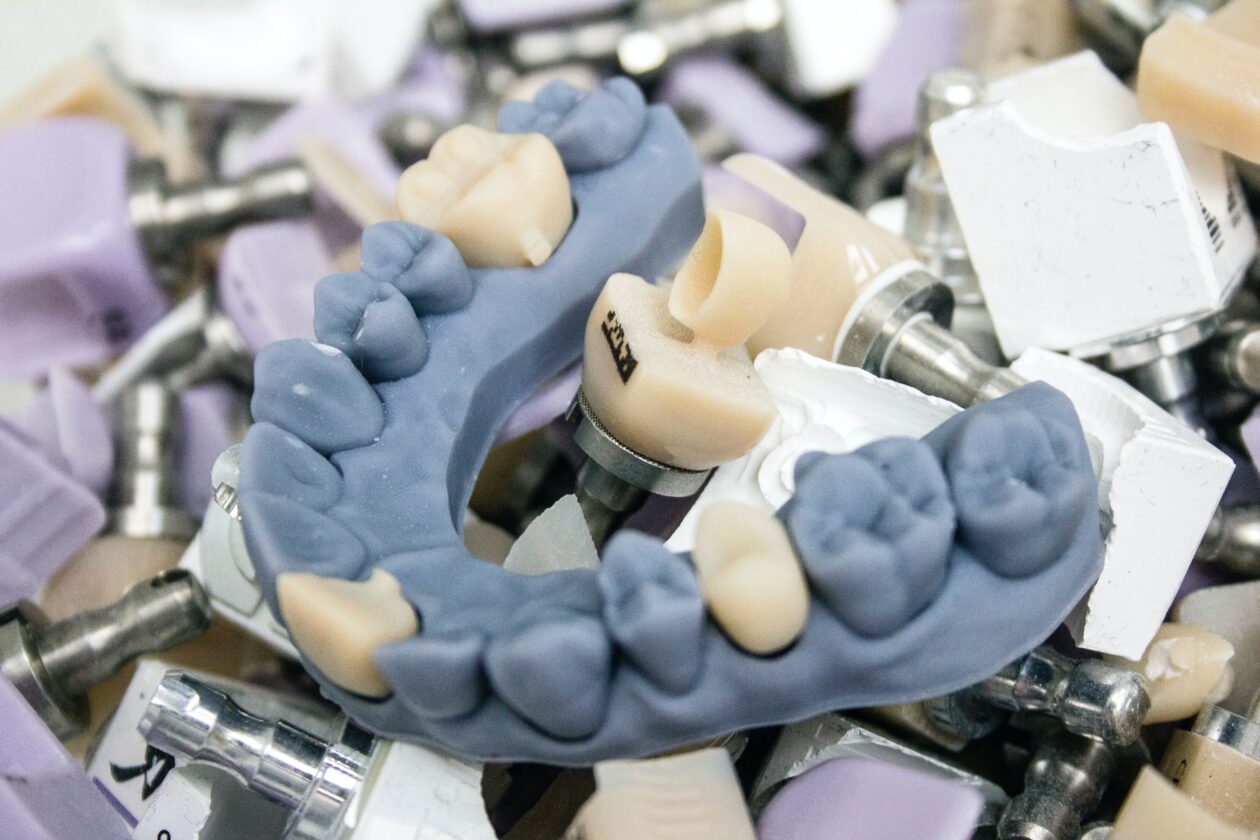Introduction
A dental sealant is a thin, protective coating put on the chewing surfaces of molars and premolars to protect against bacteria that cause cavities. Children and adolescents must take this preventative action, typically done by dentists, to ensure their oral health remains in the best possible condition. The primary objective of dental sealants is to protect the deep pits and grooves of the back teeth. These are the areas of the teeth where food particles and bacteria frequently become lodged, which can eventually contribute to tooth decay.
How Soon Can You Eat After Sealants? This subject becomes important after administering dental sealants. It is essential for persons about to have this preventative dental operation to clearly understand the timetable for returning to their regular eating habits.
A thin coating of liquid is applied to the chewing surfaces as part of the process, which is then followed by a phase in which the coating cures and becomes more rigid. Following the completion of this period, individuals are typically able to resume their typical eating regimen. Despite this, it is essential to delve deeper into the particulars of post-sealant habits to guarantee that the operation will be successful and that the sealants will withstand the test of time.
As we delve deeper into the specifics of how soon you can eat after getting sealants, it is essential to keep in mind that the period immediately following the application of sealants is defined by the possibility of experiencing an odd sensation or discomfort while biting into specific foods. There is a possibility that the new sealant is responsible for this sensation; however, it usually disappears within a few days.
To ensure a smooth transition back to regular eating patterns, it is essential to have a solid awareness of the post-sealant phase and the necessary alterations in behavioral patterns around diet. In the following parts, we will explore expert guidance on food choices, the drying process, and recommended soft meals. These sections will offer vital insights to help you properly traverse this post-sealant phase.
Immediate Post-Sealant Procedure

Many people are curious about the time before they resume regular eating and drinking after a dental sealant surgery. The good news is that, in most cases, consumers can immediately continue their standard food patterns after the appointment for dental sealant. Sealants are applied easily, and once the operation is finished, there are usually no severe limits placed on the consumption of food or beverages.
Nevertheless, it is of the utmost importance to be aware of a potential adverse effect that certain persons may experience immediately following the sealant application. When biting into something, it is not unusual to experience a peculiar sensation or discomfort due to the new sealant on the teeth. This brief sensation typically disappears after a few days as the individual becomes accustomed to the sealant’s presence in their environment. When consumers know this is a natural part of the adjustment process, it can help reduce any concerns they may have over the initial experience following sealant application.
Individuals should gradually resume their regular eating patterns to successfully navigate the initial post-sealant period. Making some modifications to be aware of the potential discomfort during the first few days can make the shift go more smoothly. The primary goal is to ensure that folks enjoy their meals comfortably while reaping the benefits of the protective dental sealants applied to their molars and premolars.
Cautionary Advice on Food Choices
When determining how soon you can eat after getting sealants, pay attention to the kinds of things you ingest in the early aftermath of the surgery. Dental professionals agree that this practice is important when it comes to avoiding being exceptionally hard, sticky, or chewy during the early post-sealant phase. These kinds of foods pose a danger of chipping or eroding the recently applied sealants, which would reduce their effectiveness in protecting the teeth from bacteria that cause cavities.
Navigating Food Choices: A Balanced Approach
Even though there is widespread agreement that some foods should be avoided, it is essential to remember that recommendations for particular food restrictions can differ. According to trusted sources, a more cautious approach is recommended, and chewy, sticky, or hard products should be temporarily excluded from the diet. Conversely, a balanced approach can involve making choices based on accurate information rather than imposing tight limits. A pragmatic technique could include selecting more gentle alternatives and gradually reintroducing traditional foods as patients adjust to the treatment.
To make the most of the benefits of the process, it is vital to have a thorough understanding of the intricacies of food choices after applying the sealant. It ensures that individuals can balance enjoying a diverse diet and protecting the dental sealants’ ability to keep their efficacy and longevity intact. Individuals can transition smoothly into their typical eating habits while maintaining good oral health if they make choices based on accurate information and are aware of the first sensitivity.
Drying Process and Duration
It is essential to have a solid understanding of the drying process of dental sealants to determine how soon you can eat after applying sealants. The application of sealants is a process that requires a great deal of attention to detail. This process entails applying a thin liquid coating over the chewing surfaces of the molars and premolars. The following step is crucial after it has been used: for the sealant material to cure and become more rigid. This procedure is quick and usually only takes a few minutes to reach total dryness. This is contrary to the widespread myths that are being spread about it.
Factors Influencing Drying Time
Several factors can affect how long it takes dental sealants to dry. The sort of material that is used in the sealant is an essential factor to take into account. Resins, whether plant or artificial, or glass ionomers, which are glass powder coupled with a water-soluble acid, are examples of the types of materials that manufacturers may consider using. Everybody has their own set of characteristics that influence the drying process. Furthermore, the rate at which the sealant material cures and when it reaches its optimal level of hardness can be affected by environmental factors such as the temperature and humidity of the surrounding environment.
With a better understanding of the dynamics of the drying process, consumers can better comprehend the limited period they need to wait before returning to their regular eating habits. Because of this knowledge, individuals can make educated decisions regarding their dietary choices after applying dental sealants. This knowledge also ensures that individuals can confidently enjoy their meals without jeopardizing the integrity of the freshly applied dental sealants.
Soft Diet Recommendations

When contemplating how soon after sealants you can eat, it is beneficial to consider the recommendations for maintaining a soft diet in the immediate aftermath of the initial application of sealants. Most of the time, individuals can resume their previous eating habits shortly after the surgery; nevertheless, a soft diet is frequently recommended during the initial period. This preventative treatment aims to reduce the likelihood of persons experiencing discomfort and provide a more seamless transition for those adjusting to the newly applied dental sealants.
Recommended Soft Foods
Adopting a soft diet does not require giving up flavor or variety in their food. People can prioritize their dental health while enjoying various soft foods. There is a wide variety of soft foods available. In addition to mashed potatoes, jello, yogurt, pudding, applesauce, and grits, some other recommended options are also included. Not only are these foods easy on the teeth, but they also offer a delicious and wholesome alternative when the teeth are recovering from the effects of the salt. Incorporating these soft alternatives into one’s diet provides a pleasant and satisfying experience, enabling dental sealants to set and cling to the teeth effectively.
Implementing a soft diet after applying sealant is a proactive approach that can be taken to assist the procedure’s success. While enjoying a wide variety of quiet meals is essential, it is also important to gradually introduce conventional foods as the initial sensitivity decreases. Striking a balance between the two is critical. Individuals can securely regulate their eating habits after applying dental sealants by sticking to these suggestions for a soft diet. This contributes to the life and effectiveness of dental sealants in protecting against cavities.
How Soon Can You Eat After Sealants?
For individuals to successfully navigate the post-sealant period, they must delve into the nuances of how soon to eat after sealants have been applied. The good news is that dental sealants make it possible to resume regular eating habits in a relatively short amount of time. In most situations, talks can continue their routine sealant administration in most the sealant. The majority enjoy their meals without having to wait for an extended period. The drying process usually takes a few minutes and guarantees that the sealant sets effectively.
Dental Professional Recommendations
Even though the general advice is to continue eating as soon as possible following the sealant session, it is essential to consider any special instructions or guidelines that dentistry professionals may present. Certain practitioners may provide individualized guidance based on the individual’s situation or the type of sealant material being utilized. To ensure that any tailored post-sealant care instructions are aligned with the treatment, it is recommended that the dentist treating the patient consult them. This will help to achieve the best possible outcome.
Potential Risks and Benefits
The ability to make educated decisions is facilitated by thoroughly understanding the potential hazards and advantages of eating shortly after applying sealant. Immediately beginning to eat again is advantageous for several reasons, including the fact that it eliminates the need for rigorous restrictions. However, individuals should be aware of potential hazards, such as consuming tricky, sticky, or chewy foods, as these characteristics can undermine the sealants that have just been applied. It is essential to strike a balance between eating a regular diet and avoiding foods that could affect the sealants to ensure that they will last as long as possible and continue to be effective in preventing cavities.
Varied Recommendations Across Sources
When attempting to answer how soon after sealants you can eat, it is vital to consider that different sites may provide other suggestions. Dental practitioners may offer nuanced recommendations based on their particular practices or the preferences that they have seen in their patients. There is a widespread consensus that individuals can generally resume their standard eating patterns shortly after applying sealant; however, the specifics may differ.
Customized Guidelines for Optimal Results
They emphasize that individuals must adhere to the particular recommendations that their dental care provider supplies are paramount. Dentists can modify their advice by the type of sealant applied, the patient’s oral health history, or any other specific conditions. It is possible to maximize the outcomes of the sealant operation by adhering to these individualized criteria, which guarantees that patients will receive individualized care. This strategy considers the individual’s specific oral characteristics, which contributes to the overall success of the dental sealants and ensures that they will last for a long time.
Navigating Personalized Care
Individuals should emphasize the importance of maintaining open communication with their dental care providers as they navigate the various pieces of advice from different sources. It is possible to grasp better the individualized recommendations offered by discussing any issues or questions regarding post-sealant care. This individualized method fosters a collaborative relationship between patients and dental professionals, which improves the dental sealants’ overall effectiveness and caters to each patient’s specific requirements to provide a smooth experience once the adhesive has been applied.
Post-Operative Care Instructions

Post-operative care instructions are essential in determining how soon you can eat after getting dental sealants. These instructions are also crucial in guaranteeing that dental sealants will last long and be effective. Following the application of the sealant, individuals are provided with instructions on essential issues, such as the selection of foods and how they should practice oral hygiene. It is of the utmost importance to strictly adhere to these recommendations to maximize the preventive effects of the sealants and ensure that any potential issues are avoided.
Guidance on Food Choices
One of the most important aspects of post-operative care is the ability to make educated decisions regarding food consumption. During the first few days following the application of sealant, it is usual practice for dental practitioners to advise patients to steer clear of foods that are highly challenging, sticky, or chewy. To ensure that the freshly applied sealants can successfully protect the teeth from bacteria that cause cavities, this preventative action is intended to protect them from any potential damage that may occur or occur. Patients may be eager to resume their regular diet; nevertheless, the direction provided assists in striking a balance between enjoying a varied diet and protecting the sealants.
Maintaining Oral Hygiene for Optimal Results
In addition to dietary considerations, the recommendations for post-operative care emphasize the significance of maintaining the highest possible level of dental cleanliness. In addition to having routine dental checkups, brushing and flossing your teeth consistently are two of the most critical factors contributing to dental sealants’ durability and effectiveness.
Using this preventative method helps to avoid the formation of plaque and debris surrounding the areas protected by sealant, reducing the likelihood of cavities and improving the general population’s oral health. Adhering to these post-operative maintenance guidelines can help individuals actively preserve the benefits of their dental sealants for a more extended period.
The importance of following the post-operative care guidelines cannot be stressed enough regarding how soon you can start eating after getting sealants. To achieve the best possible results, individuals should make it a top priority to adhere to the instructions that their dental care provider offers. Dental sealants effectively prevent cavities and support long-term oral health with this proactive approach, which includes making conscious food choices and practicing attentive oral hygiene routines.
Addressing Common Queries
It is vital to address related questions that folks frequently have after sealants have been applied, such as how soon you can eat after sealants have been applied. For example, “Can you drink water after sealant?” is a question that is regularly asked. To address your question, the answer is yes; folks are often able to drink water immediately following the sealant treatment. Water does not have any adverse effects on the newly placed sealants, in contrast to certain types of food that could have a negative impact. Individuals should not hesitate to consume water immediately after the sealant session because maintaining proper hydration is essential for overall health and well-being.
In addition, a frequently asked question is, “How long does it take for dental sealants to feel normal?” The adjustment period after sealant application varies widely. When biting into anything, some people may experience a momentary feeling of strangeness or pain, even though the drying process typically takes a few minutes to complete.
As individuals become accustomed to the new sealant’s presence, this sensation generally disappears within a few days throughout the learning process. Individuals can anticipate that their treated teeth will feel normal immediately after the sealant’s administration. It is crucial to know that this temporary adjustment is a regular aspect of the experience after applying the sealant.
Potential Risks, Benefits, and Necessity of Sealants
In addition to the questions that arise immediately after applying sealant, it is beneficial to investigate more general elements, such as the potential risks, the advantages, and the necessity of sealants. Dental sealants provide significant benefits because they are a barrier that prevents microorganisms that cause cavities from entering the mouth.
It is estimated that approximately 42 percent of children aged 6 to 11 and 48 percent of adolescents aged 12 to 19 in the United States have dental sealants on their permanent teeth. This demonstrates dental sealants’ widespread acceptance and effectiveness in preventive dentistry. Sealants are typically warmly welcomed; they must know their potential hazards. These risks include the need to replace sealants every five years and the significance of proper placement to prevent germs from being trapped and cavities from being caused.
When patients are provided with answers to these frequently asked questions, they are provided with a thorough awareness of the immediate post-sealant experience and broader concerns about the necessity, advantages, and potential hazards of dental sealants. By gaining this knowledge, individuals are able to make educated decisions regarding their oral health. They are encouraged to take an active role in maintaining the highest possible level of dental hygiene.
Encouragement for Regular Checkups
When it comes to how soon after getting sealants, you may start eating, it is essential to maintain a continuous relationship with dental specialists to maintain excellent oral health. When sealants are applied, individuals are strongly urged to engage in active consultation with their dentists to address any questions or concerns regarding the experience. Dental professionals play a significant role in providing consumers with specialized assistance and ensuring they receive reliable information tailored to their circumstances.
Proactive Maintenance through Regular Dental Checkups
In the context of post-sealant treatment, it is essential to emphasize the significance of regularly scheduled dental examinations. When it comes to dental care, it is recommended that patients make routine appointments with their dentists at least once every six months. During these appointments, dentists or hygienists can analyze the overall health of the teeth and gums, review the condition of any sealants that are currently in place, and provide any recommendations that may be required for ongoing oral care. These checkups are preventative steps to promptly identify and manage potential problems, contributing to dental sealants’ success in avoiding cavities over the long run.
Empowering Individuals for Optimal Oral Hygiene
The participation of dental experts not only guarantees that sealants will continue to be effective over time but also gives individuals the ability to take an active role in maintaining their oral hygiene health. Individuals can get vital insights into maintaining a healthy oral environment by discussing changes in oral health during routine appointments with professional dental care providers. This collaborative approach encourages individuals to take a proactive posture toward their oral health and well-being by fostering collaboration between themselves and the dental care clinicians responsible for their treatment.
It is possible to lay the groundwork for long-term dental health by encouraging patients to take an active role in their oral care journey by ensuring frequent checkups. Because of the relationship between individuals and dental professionals, individuals can receive continuous support and guidance and appropriate management of dental sealants, which helps prevent cavities for an extended period.
Conclusion
In conclusion, how soon after sealants you can eat depends on the procedure immediately after applying the adhesive and the subsequent considerations. In most cases, individuals can resume their normal eating and drinking routines immediately following the appointment for dentistry sealants. Because of the new sealant, it is possible that you could have a peculiar sensation or discomfort while biting into something; however, this sensation will typically disappear within a few days. Considering the consensus that prevents the newly applied sealants from being damaged by excessively tough, sticky, or chewy meals is paramount.
To guarantee that dental sealants are effective, one must carefully consider the foods one consumes. Even though the drying procedure usually only takes a few minutes, strict adherence to post-operative care recommendations is essential to ensuring that sealants last as long as possible and provide the desired advantages. Even though the benefits of dental sealants outweigh the drawbacks, people should be informed that sealants have a lifespan of around five years and must be replaced regularly. To ensure that dental sealants are effective in preventing cavities, it is essential to consult with dental professionals and adhere to individualized guidelines based on the specific circumstances of each case.
Your experiences and questions are precious in cultivating an active community in oral health. If you have any opinions, please express them in the comments section below. Explore the links provided to provide you with ongoing education and a wealth of information if you are interested in gaining additional insights on related issues or if you wish to delve deeper into preventive dentistry. It is important to remember that your active participation constitutes a contribution to the overall path toward excellent oral health.
Reference
Clinic, C. (2023). Dental Sealants: How They Work. Cleveland Clinic. https://my.clevelandclinic.org/health/treatments/10912-sealants
Affordable Dentist. (2023, January 19). How Long Does It Take for Dental Sealants to Dry? Affordable Dentist near Me. https://affordabledentistnearme.com/how-long-does-it-take-for-dental-sealants-to-dry/
Was this helpful?

Joseph Emb, RDN
Founder of StyleVitally.com | Registered Dietitian & Wellness Advocate
What I Cover:
I’m passionate about connecting nutrition science and everyday wellness to help people live healthier, more vibrant lives. I write about evidence-based nutrition, mindful eating, sustainable lifestyles, and holistic well-being at StyleVitally.com.
My Background:
The University of Texas in Austin, where I earned my Dietetics diploma, laid the groundwork for my nutrition and health career. My training and hands-on experience taught me the science and art of using nutrition to enhance health and well-being.
Professional Journey:
I’m an RDN with lots of experience. I’ve helped people seeking tailored nutritional recommendations in clinical settings and community outreach programs. My constant learning and professional development ensure that my recommendations are always based on the latest evidence.
Ethical Commitment:
My practice prioritizes integrity. My content is transparent and objective, following the most significant ethical standards. I can give my audience unbiased advice because I’m not affiliated with food businesses or industry associations. I want to help people make informed health decisions that match their values and ambitions.
Join Me on the Wellness Journey:
Join me on the path to vitality and well-being, whether facing nutritional issues, seeking sustainable lifestyle changes, or simply wanting a better, happier you. We’ll discover how diet, mindfulness, and holistic well-being can maximize your potential.










Leave a Reply
View Comments